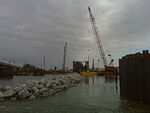Seabrook Bridge
Bascule bridges in the United StatesBridges in New OrleansLouisiana building and structure stubsLouisiana transportation stubsRoad bridges in Louisiana ... and 1 more
Southern United States bridge (structure) stubs

The Seabrook Bridge (officially the Senator Ted Hickey Bridge) is a medium-rise twin bascule, four-lane roadway bridge in New Orleans, Louisiana, carrying Lakeshore Drive, connecting Leon C. Simon Drive on the upper side of the bridge with Hayne Boulevard on the lower side. The bridge is operated by the Orleans Levee District. It normally stays in the down position for vehicular traffic, but provides sufficient clearance for most marine traffic.
Excerpt from the Wikipedia article Seabrook Bridge (License: CC BY-SA 3.0, Authors, Images).Seabrook Bridge
Seabrook Bridge, New Orleans
Geographical coordinates (GPS) Address Nearby Places Show on map
Geographical coordinates (GPS)
| Latitude | Longitude |
|---|---|
| N 30.0318 ° | E -90.0345 ° |
Address
Seabrook Bridge
Seabrook Bridge
70126 New Orleans
Louisiana, United States
Open on Google Maps










